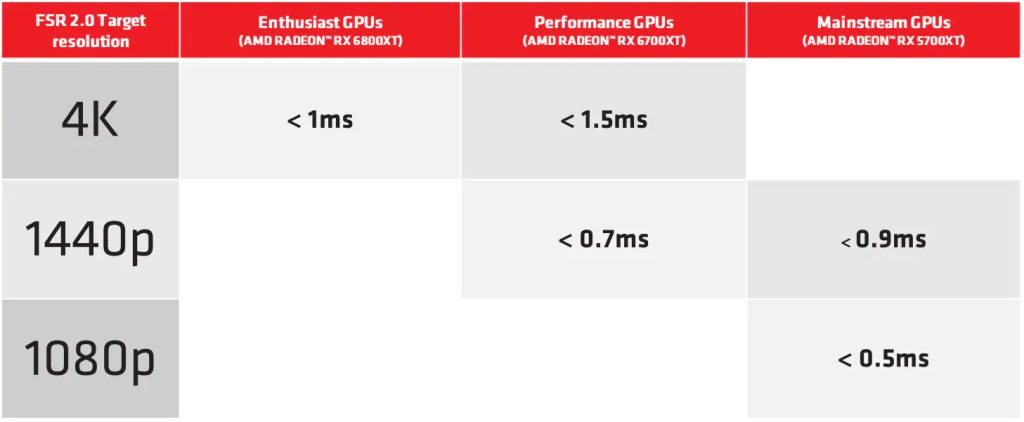AMD has pulled the curtain on FSR 2.0, revealing how the new technology works. Besides the relatively fast implementation, the new upscaling technique will be supported by Nvidia GeForce GTX 10/16 and RTX 20/30 series graphics cards, as well as AMD GPUs. As for image quality, early reports indicate major improvements.
AMD FSR 2.0 was properly unveiled during GDC this week. The new tech is based on six pillars:
- Temporal – Delivers similar or better than native image quality using temporal data
- Anti-aliasing – Includes high-quality anti-aliasing.
- FSR 2.0 replaces any TAA within the game frame.
- High image quality – Higher image quality than FSR 1.0 technology at all quality presets/resolutions.
- Different quality modes available.
- Dynamic Resolution Scaling supported.
- No machine learning – Does not require dedicated Machine Learning (ML) hardware.
- More platforms can benefit.
- Gives more control to cater to a range of different scenarios.
- Better ability to optimize.
- Cross-platform – Boosts framerates in supported games.
- Wide range of products and platforms, both AMD and select competitors.
- Open source – Will be provided on GPUOpen under an MIT license.

The time to implement AMD's new upscaling solution greatly varies. If a game already supports DLSS 2.0 or higher, it takes less than three days to add FSR 2.0 support. Using the Unreal Engine 4/5 plugin, it should take developers about a week, but the time can increase up to four weeks for games that don't support decoupled display/render resolution or Motion Vectors.
Although the image above only shows three FSR 2.0 quality modes (Quality, Balanced and Performance), there's also an optional fourth mode called Ultra Performance. This mode will render the image at a third of the screen resolution to maximise performance as much as possible. You can check the scale factor (input/output resolution) of each quality mode in the table below:

Like some other upscaling technologies, FSR 2.0 will also support a sharpness slider so users can better adjust how the image looks. Moreover, it will support Dynamic Resolution Scaling, allowing it to work even when the system changes source resolutions to maintain the targeted frame rate.
Compared to its predecessor, FSR 2.0 will be more demanding to the GPU, but users will still see noticeable frame rate improvements when using the technology. The following table shows the impact when enabling FSR 2.0 in Quality mode:

As for the next table, it shows the performance overhead when using FSR 2.0 in Performance mode:

According to AMD, FSR 2.0 will be supported by Radeon graphics cards (RX590 recommended as the minimum) and Xbox series consoles. GPUs from other vendors are also supported, including Nvidia GeForce GTX 10/16 and RTX 20/30 series graphics cards. The PS5 and Intel Arc graphics cards weren't mentioned.
FSR 2.0 will become available for developers starting next quarter. The first games capable of using the new upscaling tech will also release or receive a patch during Q2 2022. At the moment, Deathloop and Forspoken are the only two games known to support FSR 2.0, but the list will surely increase as the year goes on.
Discuss on our Facebook page, HERE.
KitGuru says: Are you interested in trying AMD's new upscaling tech? Will FSR finally be able to rival DLSS for image quality?
 KitGuru KitGuru.net – Tech News | Hardware News | Hardware Reviews | IOS | Mobile | Gaming | Graphics Cards
KitGuru KitGuru.net – Tech News | Hardware News | Hardware Reviews | IOS | Mobile | Gaming | Graphics Cards


